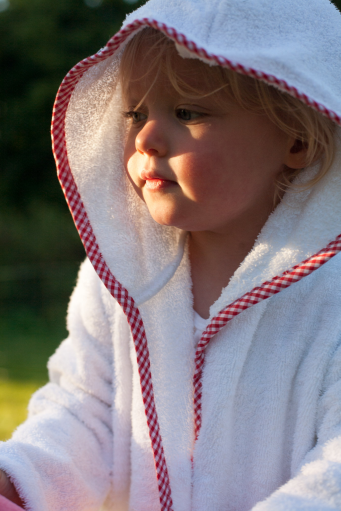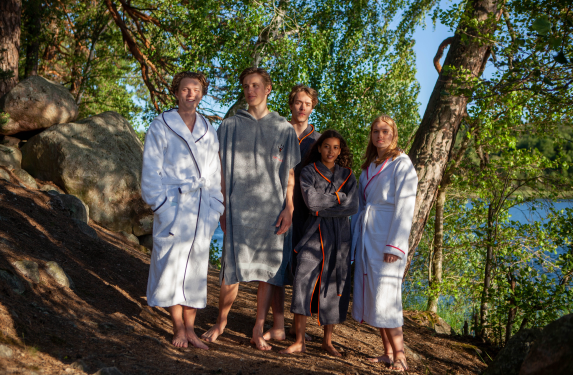06.12.2021 (Caucasian Journal). Does a “100% cotton” label always mean that the garments (or linens, towels, etc) are safe to use? Are second-hand clothes better for a baby? How a business can use waste to manufacture top quality product and generate profit? Why is this relevant to hotels? What is ethical about recycling?
These are some questions which we have for our new guest - Caroline von POST (Sweden), a biologist, circular economy consultant, and head of an aptly-named company, Stormie Poodle.
▶ ქართულად: Read the Georgian version here.
▶ Հայերեն: Read the Armenian version here.
Alexander KAFFKA, editor-in-chief of CJ: Dear Caroline, welcome to Caucasian Journal, and greetings from South Caucasus. This region is known for natural beauty, rich history and hospitality, and it is small wonder that tourism is one of our main backbones. As you can guess, I’m about to ask about the hotels. Is it true that you know a “magic” way for hotels to become more environmentally friendly, reduce waste, and make profit?
Caroline von POST: Haha, of course, they could let me help them! No seriously, it’s a complicated thing, running a hotel. Positioning your brand, employing the right staff who can represent the hotel in a positive manner, cooking great food, decorating the rooms etc… so many things to think about. While I have helped hotels become more environmentally friendly prior to launching Stormie Poodle, my business now focuses on the textiles that are used by the hotel and “upcycling” those textiles to – as you say – reduce waste, become more environmentally friendly, and increase profits.
Your country seems like a very beautiful place with so much biodiversity and amazing mountains. I hope I get the chance to visit it one day.
AK: You are a biologist, so obviously your business model has a scientific component in it. It is aimed not just on recycling the waste, but also on producing garments which are safer to use. From a biologist’s viewpoint, what’s wrong with ordinary textiles? Is it true that they may contain phthalates - chemicals, which are harmful especially to children?
CVP: There are literally thousands of chemicals involved in the manufacture of textiles – from the cotton fields where fertilizers and pesticides are used to the dyeing and treatment to make the textiles look nice. We are constantly in contact with textiles in our environment – our clothes, bedding, carpets, furniture, towels, car interiors etc - and so safety and confidence in these products is vital. They can be made of natural or synthetic fibers but any allergic reactions or health implications are generally as a response to fiber treatments, such as dyeing and other chemical finishes, rather than the textile itself.
Textiles are treated with all sorts of chemicals to improve their look, function and wearability. Unfortunately, many of them are carcinogens, hormone disruptors and can cause allergic reactions – we can inhale the chemicals or/and absorb them through the skin. Often it’s children and expectant mothers who are most sensitive to these chemicals, so limiting exposure is important for their health.
As of October 2020 the use of so-called CMR substances (carcinogenic, mutagenic or toxic for reproduction) has been greatly limited for 33 substances by the EU. This limitation affects textiles such as bedding, furniture fabrics, shoes and clothes, both made within the EU and imported.
AK: Even the Nordic standards and labels, which we believe have the strictest requirements, are not good enough to ensure the safety of textiles?
CVP: There are labels and standards that are supposed to protect users of textiles, but there is also an indefinite amount of chemicals out there, and it’s very difficult to keep track of all. Certifications that help companies and consumers make better, more environment-friendly choices such as Oeko Tex, Nordic Swan Ecolabel and Global organic Textile Standard, differ in their criteria; ranging from needing to adhere to a certain chemical limit level, to the examination of the enter supply chain.
Of course, with long global supply chains, it can be very difficult for a producer to know if the right levels are adhered to or not.
AK: So, your concept is based on 3 pillars – scientific (to eliminate harmful chemicals), environmental (to reduce waste), and business (to generate profit, improve marketing). Is that correct? Can you tell us more about your work?
CVP: Stormie Poodle started out as a children’s brand with the aim of making nearly chemicals-free clothes for children. We wanted our products to be made in a way that actually contributed to someone else’s well-being. From the beginning, we wanted Stormie Poodle to be your go-to place for sustainable bathrobes. We’re now also making “upcycled” bathrobes, ponchos and bucket hats for adults and, come next summer, a sweater.
We’re working mostly with businesses nowadays, upcycling their textiles and providing them with a great story – often in the form of a sewn label explaining where the material comes from and who has made the product. This helps build their brand. Internally it contributes to employee’s engagement and also strengthens the brand – the company stands out amongst its competitors, attracting better talent and positions itself as an environmental leader.
Stormie Poodle still stays true to our values: upcycling discarded textiles, always with small-scale local manufacturers, making life better for many.
AK: Your approach sounds very much 21-century. But what about your potential counterparts – the business companies? How many of them are responsive to your offer? Do you feel that they are mostly motivated by ethical considerations, or by “cold” business calculation?
CVP: I’d say that the consumers are very aware nowadays and many businesses realize that “there’s no business on a dead planet”, so they have to change the way things are done. Of course, money is still an issue, but businesses are educating themselves. More and more companies are working hard to limit the damage they do to nature and many companies have set ambitious science-based targets to reduce their emissions.
AK: Your business counterparts are mostly from Scandinavia and Baltics. Perhaps there is some connection to the mentality and traditions of your region? We know about “lagom” (meaning "just the right amount, not more, not less”), which seems like a whole approach to life. Among other things, lagom mentality must be friendly to using second-hand clothes, to say nothing about the recycled clothes?
CVP: Actually, lagom is slightly different, but you’re right that on some level the concept of lagom shapes how Swedes think about and try to be prudent in our use of resources. For my company, we’ve chosen to operate as locally as possible across our entire supply chain, because transporting goods is not very sustainable. We source our materials in Sweden and ideally manufacture our products as close to these sites as possible; in addition to lower emissions and being environmentally friendly, it creates work opportunities locally as well.
AK: This brings me to a more general question about “lagom” attitude, typical for many Swedes and other Nordic peoples. We see its manifestations in the Scandinavian furniture, design, fashion. What’s the connection between “lagom” and sustainable living, recycling, etc? What’s the role of “lagom” thinking in Nordic lifestyle in general?
CVP: Well, I’m not so sure we’re very lagom in our doing nowadays as we’ve become so influenced by other cultures where it’s more accepted to be extravagant or “a bit too much”. I do agree with you that a lot of the furniture, design and fashion that comes from Sweden is very elegant in all its simplicity. We use a word for it: “avskalat” which literally means “peeled”, as in a peeled orange or banana, nothing extra. Basically, well-thought through minimalist designs, which are timeless. There is definitely a great deal of awareness of the importance of sustainable design and production among Swedish designers.
AK: My next question is connected. We see mentions about being ethical time and again in Stormie Poodle website, but also in many other Nordic documents, including the governmental and other official texts. Do you think the importance of “ethical” argumentation is growing in your society?
CVP: Absolutely. Today we’re used to “fast fashion” hardly costing us anything, but more and more people are waking up and asking how can this garment only cost 5€? The Rana Plaza incident in Bangladesh [A garment factory collapse killing 1,134 people in 2013 - CJ] really made many realize that our cheaply bought clothes means that someone else far away is paying the price. Also, the pandemic has shown us that manufacturing far away can be costly when transportation costs increase. The cost of shipping goods in a container from Asia has gone up 7 times since 2018 – who is going to pay for that? In Sweden we’re seeing more and more brands searching for local production.
I really believe that production can be ethical without having the label. It means workers are paid a living wage – not just a minimum wage.
AK: Going back to your practical work… How would you define “ethical upcycling”?
CVP: Well, there is an internationally well-known ethical certification called Fair Trade that has standards for sustainable sourcing and production – so in a way nothing is ethical unless it has their label. Of course, one would wish that every ethical manufacturer was Fair Trade labeled, but they’re not. I really believe that production can be ethical without having the label.
To me it means that the workers are paid a living wage – not just a minimum wage – the one that allows them to send their kids to school, buy medicines, clothes and food, pay rent etc. It also means that workers are allowed to organize themselves and be members of a union without being punished in any way. At Stormie Poodle we work with the organization Dzīvesprieks in Latvia which doesn’t have the Fair Trade label but it stands for so many good things – such as providing scholarships for about 100 underprivileged youths so that they can pursue high school and university studies. Ethical manufacturing costs more than sweatshop labor because it reflects the true value of what you are buying. Working with upcyling of textile waste is in itself a very labor intense process.
Ethical manufacturing costs more than sweatshop labor because it reflects the true value of what you are buying.
So how do you know if a manufacturer is treating their workers fairly or not? Well, for me, working with very small organizations meant building long-term relationships with each and every one of them – all the way through the organization: the seamstress, the managers to the owners. Obviously, it’s much more difficult if it’s a very big factory. It’s important to visit the site, speak to the workers yourself and get a feel of the place. I used to source textiles from one laundry and I got the feeling that the workers there were somehow uncomfortable with my presence. I didn’t know why, but when I did some digging I found out that the manufacturing site had a long history of issues with how their workers were treated. We stopped sourcing our material from them, of course.
AK: If you could provide some vivid examples, or success stories from business world, that would be especially interesting.
CVP: We’re very proud of the project that we did together with a laundry company and one of their customers which was a hospital. This time we didn’t work with towels but with work-wear. The work-wear was to be incinerated but there was still a lot of “life” left in them. We managed to save the garments from being destroyed and created several new products out of them instead. One of these was actually a new insulated vest for the staff. This vest now circulates between the laundry and the hospital – in a way you can say that the laundry is making money off its former waste.
Another example is when one retailer who sold our bathrobes and ponchos at a summer resort also started to rent them out to vacationers. This is exactly the kind of thing we must start doing in order to save resources. Not everyone is in need of a bathrobe year round but when you visit a summer village by the sea where bathrobes are part of the dress code it’s nice to be able to rent one.
AK: Can you share a bit about your company Stormie Poodle? What do you consider as important achievements, and future prospects? And, of course, what’s in the name?
CVP: You know, it’s been nearly thirteen years since I started my company and when I did no one understood what on earth I wanted to do. Luckily, times have changed. In 2015 all United Nations Member States adopted the Agenda for Sustainable Development. Citizens, companies and states have woken up to the challenges we’re facing, and many have realized and are acting upon the need to drastically change the way things are done.
When Stormie Poodle first started, we only made products for small children, but in 2017 we started to make bathrobes for adults too, which were a great success. That year we also started to collaborate with a hotel chain and made some new products for them out of their discarded textiles.
We take textile waste and turn it into premium products.
Love that you ask about the name! Have you seen the logo? If you know your dogs then you can see that the dog in the logo is not a poodle. Stormie is actually a woman’s name and Poodle is her last name. We want to question the way you look at things, like, don’t judge a book by the cover and give everybody a second chance. Most people wouldn’t want to touch textile waste but we take textile waste and turn it into premium products. If you didn’t know better you’d think our products had been made out of brand new material.
AK: Can you tell us about yourself, how you became a business owner starting from a scientific education?
Why do we dress babies in brand new clothes that are full of chemicals? I came to conclusion that the used clothes felt better in so many ways.
CVP: When I grew up in Southeast Asia, I saw a lot of hardships and it opened my eyes to how much inequality there is in this world. It made me very aware of how fortunate and lucky I was. I feel very strongly that if you have an opportunity to make a difference, it’s your moral obligation to at least try.
I realized that if I could find a high quality fabric that had been washed many times then new clothes could be made for children and that, in my way of looking at it, was a healthier option. I found my material quite fast – the hotel linen, made some drawings and found a manufacturer that shared my values. The rest is history!
AK: If there is anything that you would like to add for our readers, the floor is yours.
CVP: Actually I would like to share with you that I am setting up a new business together with an upcycling designer, Susanne Beskow. We will be focusing on another kind of textile used by hotels: workwear. Can’t tell you much more about it yet but I’ll let you know when we launch. Thanks so much for this interview Alexander, it’s been a pleasure talking to you today.
AK: Thank you very much!
Caucasian Journal appreciates kind support of Estonian Embassy in Tbilisi in preparation of this interview.
Photo credits: Johan Larsson







No comments:
Post a Comment